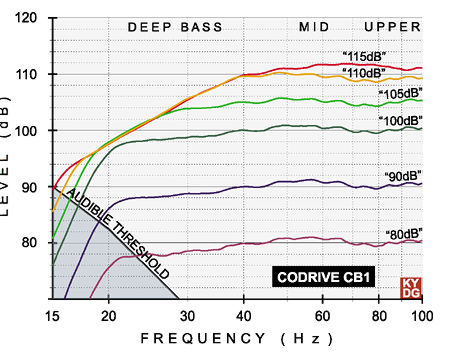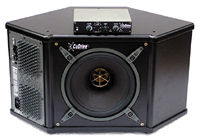Way Down Deep III CoDrive CB1
With its corner-hugging shape, the CoDrive CB1 will have instant appeal to the space-challenged. But it's not only the quasi-triangular footprint that's novel. Even a quick glance leaves you with the sense that something different is going on here. A moment later, you think you get it: The ubiquitous dome-shaped dustcap in the center of the driver is missing, its place apparently occupied by a bit of skeletal bracing that permits a partial glimpse into the guts of the unusual drive system.
But why the hole in the middle of the driver? Topsfield, MA-based CoDrive's claim to Internet-fueled fame resides in designer Ron Coffin's patented "compound driver" (hence, CoDrive), which places a front-facing 12-inch cone and inverted 10-incher back to back, separated by a few inches, the rear unit's output passing through the 10-incher's 3-inch throat (Fig.1). The unit I tested had its processor-crossover unit integrated with the 1000W RMS power amp inside the sub enclosure; current production units break the processor-crossover out into its own rack-mountable enclosure.

Fig.1: Driver for CoDrive CB1
The processor includes a rotary EQ knob that tilts the response up or down around a pivot point at 50Hz, the idea being that "room gain" varies from room to room (and even within a room, depending on whether a door is open or closed, for example). The EQ control also adjusts the sub's response at the bottom to complement the room's natural lift in the low end.
At the 80dB/meter playback level with the EQ knob turned down fully counterclockwise, the CB1's response was –8.7dB at 20Hz compared to the 50Hz reference, and +1.8dB at 100Hz. With the EQ turned up fully clockwise, the 20Hz response was –2.3dB and the 100Hz was –1.4dB, both referenced to the level at 50Hz. For the remainder of the tests, I set the knob at its midpoint (12 o'clock) and left it there, reasoning that it would be close to the "average" setting used by CB1 owners. Ron Coffin confirmed by phone that this would give representative results.
Measurements
Frequency response at 80dB (Fig.2): 20–100Hz, +/-3.3dB; –11.5dB at 18Hz. Response showed a broad but slight rise in the 50–60Hz range.

Fig.2: Frequency Response vs. Output
Frequency response at higher levels (Fig.2): The basic response shape remained intact up to and including the 100dB/m playback level. Driven 5dB harder, to a nominal 105dB, the response softened below roughly 24Hz; at 110dB, the sag started at about 33Hz. At the 115dB playback level, the fade began at about 38Hz.
Dynamic range: The CoDrive had negligible power compression up to about 105dB, but increasingly higher compression (reduced output at lower frequencies) at higher drive levels (Fig. 3). Compared to the 11 other subs in this survey, all of them physically larger than the CB1, Linkwitz shaped tone-burst tests showed the CoDrive to be a weak performer in terms of maximum output before audible distortion (Fig. 4).

Fig.3: Power Compression

Fig.4: Shaped Tone-burst Peak Output
Total harmonic distortion (Fig.5): At 31Hz and above, THD was held to <10% at all test frequencies and playback levels except the 31Hz test at 115dB, where distortion registered rough-ly 17%. The CB1 was noticeably more ragged below 31Hz even at 110 and 105dB, where the third and fifth harmonics were especially prominent.

Fig.5: Total Harmonic Distortion vs. Frequency & Level
Listening
If you want to turn that final "Jurassic Lunch" dino clomp into something that conjures a T. rex–sized killing machine stalking the jungle floor, you'll need massive wallop below 20Hz, something neither CoDrive's corner-hugger nor the vast majority of its more imposing competitors could muster. The CB1 turned the temblor into a 101dB thump (all the sound-pressure levels referenced here and below, except as noted, were taken at 2 meters, with the subwoofer played alone and the B&K sound-level meter set to C weighting, fast), with most of the energy concentrated in the 22–26Hz range (Fig.A2). It was enough to suggest an animal setting a ponderous foot down—admittedly, not a multi-ton dinosaur or even an elephant, but possibly a young Holstein.
 Turning it up brought on power compression and driver breakup noise, the audibility of which naturally increased with increasing playback level. While it outperformed the larger Adire and SRT Hydrosonic units reviewed in Part II and rivaled the Triad unit reviewed here, the CB1's peak output and low-frequency reach were too circumscribed to turn this track into the hair-raising sonic experience it can be.
Turning it up brought on power compression and driver breakup noise, the audibility of which naturally increased with increasing playback level. While it outperformed the larger Adire and SRT Hydrosonic units reviewed in Part II and rivaled the Triad unit reviewed here, the CB1's peak output and low-frequency reach were too circumscribed to turn this track into the hair-raising sonic experience it can be.
Setting up a subwoofer in the great outdoors and listening to it contend with the depth charges in U-571 can be an enlightening experience. Most subs in the CoDrive's size range turn what should be bone-rattling explosions into something sounding like a kid swatting a La-Z-Boy with a stick of day-old French bread. The CB1 made the detonations sound reasonably solid and credible up to 107dB, beyond which fluttery distortion began to intrude on the peak at 1:19:50 (Fig.B2).
I suspect many prospective purchasers of compact subwoofers will find the CoDrive's performance on this track riveting, even revelatory; yet it's hard to fathom what you may still be missing if you haven't experienced the hull-racking, gut-twisting panic unleashed by, say, the Genelec reviewed in Part I or the ServoDrive in Part II. Given that I had those hulking units, among others, on hand for six months of level-matched comparisons, the CoDrive impressed me not so much for its ability to relay the raw physicality intended by the filmmakers as for how neatly it struck a real-world compromise among performance, size, price, and what might be termed "tuckability factor."
My excitement at having found a small sub with something special slipped a bit when I played the Pearl Harbor selection, in which Cuba Gooding Jr.'s character grabs the guns and begins his desperate defense of the anchored fleet (Fig.D2). A cardboardy fluttering set in at 1:36:51 at 103dB. It was at this same level that the yellow Compress light began to flash on the crossover, indicating that the system was at the end of its linear operating range. Yet even at levels just below its 103dB max, the CB1 turned in a less than genuinely stirring performance on this cut, not so much because of a shortage of sheer level—though that contributed to it—as the sense that Gooding's weapon didn't pack enough low-end slam to bring down a brazen Zero.
The droops at the left end of its 110 and 115dB frequency-response traces help explain why the CB1 had a tough time instilling dread as the Marines scrambled to the choppers in Black Hawk Down's famous "F'ing Irene" scene (Fig.C2). That clip's emotional power draws largely on the 18Hz component of the chopper's drone (the red vertical stripe second from the left in Fig.C1). Among the dozen subs in the survey, the CB1 tied with the Triad for weakest output on this clip, managing a peak level of 99dB before a cardboard-like distortion set in.
The bass drum in the Casper soundtrack sounded pristine until peaks topped 98dB, whereupon each stroke arrived in a fluttery, crackly wrapper. With the main speakers playing, the distortion was less noticeable due to masking, but still I wished the sub could muster 3 or 4dB more oomph on this track.
I had no such reservations on the remaining tracks. The chopper landing starting at 26:35 into Apocalypse Now Redux came across cleanly and convincingly at anything short of show-off levels. With Blue Crush, the CB1 fashioned a fair facsimile of oceanic fury, and with The Matrix it created an air throb not inconsistent with the visual report of a chopper crashing into a skyscraper and exploding.
The music tracks—Tchaikovsky's 1812 Overture, Holst's First Suite, and Béla Fleck's "Cosmic Hippo"—came off neatly, with no sense of grit, bloat, or overhang. On these, it took level-matched A/B comparisons with larger, costlier subs to disclose that the CoDrive wasn't the last word in dynamics or low-end extension.
The Bottom Line
While it couldn't compete with the burliest subs in the survey for sheer pants flappage, the CoDrive outplayed several bigger and pricier competitors that passed through my plein-air lab during the six months of testing. Its corner-friendly footprint creates the prospect of getting real bass without having to decorate around it. And the 5–6dB of additional level gained by adding a second unit may be all that's needed to hook those who want their low-frequency effects served full strength.
Specifications
CoDrive CB1 powered subwoofer in MDF cabinet
Driver: compound design comprising 12" forward-facing cone & 10" inverted cone driven by a single neodymium motor
Frequency response: 20–180Hz, +/-6dB
Inputs: Neutrik combo jack (XLR & 1/4") input; gold RCA-to-1/4" adapter included; XLR connection for looping to additional subs
Amplifier: 1000W RMS
Highpass filter: selectable, 50, 63, 80, 100, 125, 160Hz; 12dB/octave
Lowpass filter: selectable, 50, 63, 80, 100, 125, 160Hz, 12dB/octave; fixed, 180Hz; 24dB/octave
Phase: 0°/180°
Finish: black catalyzed urethane paint
Dimensions: 30.1" x 16.1" x 17.3" (WxHxD)
Weight: 84 lbs
Price: $3000
CoDrive
(978) 887-8899
www.codrive.com
- Log in or register to post comments


























































